7 ways balls can build Language
Let’s get the ball rolling (see what I did there). This mother guilt thing is real. You really want to spend time with your young child developing early language skills but you’re not really sure exactly what to do or how to do it. Kids are demanding, the washing isn’t washing itself, your hair desperately needs a wash and you wonder if you’re even doing a good job.
First time mums struggle because they feel they are just fumbling along in this motherhood journey. Mums with older kids worry that their younger kids don’t get the one on one time they crave.We hear you- loud and clear. Playing constructively with your kids is actually a lot more involved than you think.
We all know play matters, it’s kids work, kids don’t get enough quality play time, kids get too much screen time etc etc. We hear it everyday but how do you actually play? and what makes it quality play?, How do you prepare?, What do you need? and Where can you do it?
There isn’t a manual for how to play with each age. This post isn’t exhaustive but if you have a baby or toddler and a ball or two you’re set. You only need a few ideas to get the ball rolling, about five minutes, a clear space (that’s easier said than done some days) possibly have your morning coffee first and you’re set.
Here’s the speechie spiel bit listing the 7 ways ball play can build language. Pretty impressive huh! Let’s look at it a bit closer and don’t let the speechie vocab put you off.
Anyone can do it. That’s the point. Playing with your kid should be easy, it should be fun and if you know just a bit more about the hows and whys you’ll realise five minutes is not that hard. Not as hard as going to the loo alone but that’s a WHOLE other blog post.
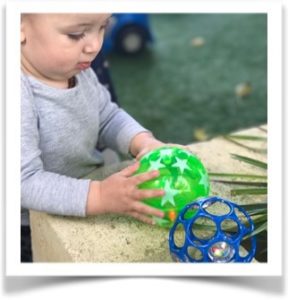
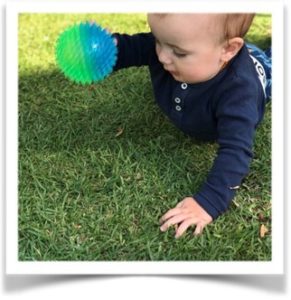
Seven Language Benefits
(Yay it’s worth not checking Insta for 5 minutes)
1. Joint Attention
Here’s my speechie definition. Joint attention is when you both focus on an object by looking or pointing. It’s important for learning language because you can’t add words to label actions or objects if your child isn’t focusing on the same thing you are.
It seems obvious but actually getting joint focus isn’t always super easy but it’s the first step. If your cherub doesn’t want to play with the awesome ball you’ve dropped in front of them you can try again in five minutes, ten minutes or when they show interest again.
The Wiggles are SUPER annoying to adults but kids just love all that exaggerated talking, arm waving and excitement. I tend to act as if the ball is this awesome orb of amazingness and roll it into the child’s view a few times to entice them to see that what I have is super fun. A light up ball is fantastic too.
Pointing at the ball and both watching it roll away helps joint attention. Kids also LOVE hearing their own names. They are quite egocentric (literally they think it’s all about them) at a young age. Little children really have a powerful need to be delighted in. Saying “yay” or “woohoo” or clapping when they share our attention really helps them become involved. Here’s a quick summary of how to establish joint focus.
Key ways establish joint attention include;
- Pointing
- Rolling the ball where your child is looking
- Saying your child’s name
- Saying “yay” or “woohoo”
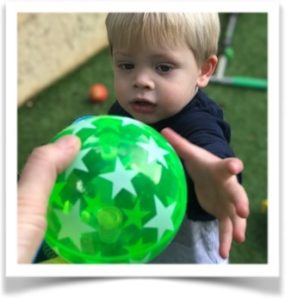
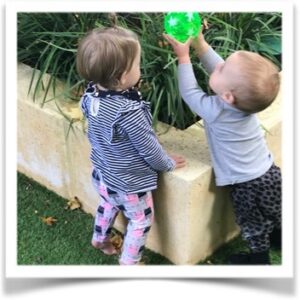
2. Turn Taking
Taking turns is one of the most important social skills needed in everyday life. Young children are not born knowing how to take turns or share. They are egocentric (it’s all about them), they have NO idea that other people have other views or feelings but they are learning.
This is what’s so cool about the humble ball. You roll it, they will probably try holding it but encouraging them to roll it back is such an important early skill.
That five minutes of rolling a ball helps them to practise the to and fro of sharing, which mimics the to and fro of conversations. Nobody likes a conversation hog (I’m totally guilty of this by the way) so you’re helping them with a life skills.
Chances are you will be imagining this beautiful “instamoment” of you turn taking with shouts of glee and all the heart eyes when, all of a sudden, your angel will simply get distracted and walk/ crawl or shuffle off. This is fine, they are still at that emotional pint sized dictator “it’s all about me” phrase. Try to act a bit like Emma Wiggle to entice them back. If they move on, then that’s fine you can try later. There will be other opportunities. Pack up your ball and try again later.
When your child does roll the ball back (you may need to really help babies or young children) you can use phrases like “my turn” whilst patting your chest and then saying “your turn” and pointing. Pronouns such as “me”, “my”, “you” and “your” are super tricky for young kids so pat your chest when you refer to yourself and help them pat their own chest and say “my turn”.
It’s ok when children are very young to use your name eg “mummy’s turn” and your child’s name eg “Eli’s turn”.
Use simple language to describe turn taking;
- “My turn”
- “Your turn”
- “mummy’s turn”
- “Eli’s turn” (obviously use your own kid’s name to avoid future identity issues ?)
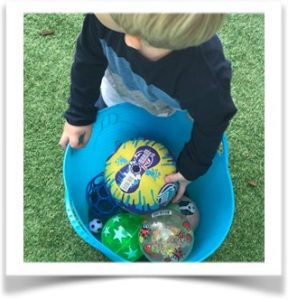

3. Requesting
Requesting is one of the first social functions of language. Most young children are extremely well practised at getting what they want by protesting or rejecting items offered. We all have surely experienced that emphatic “Noooo!”, the tantrum and pout, the ditching offered food/ toys/ items or the high pitched unintelligible scream, that makes onlookers think you’re hurting your offspring. If you don’t know anything about this, you are very very lucky and definitely in the minority (Do you even have a young child?).
Teaching your child to “request” an object or action rather than protest or reject what is available or offered is a very powerful language skill. Having the ability to request actions or objects means children are less likely to meltdown or tantrum to get their needs met. I say less likely because obviously children who can request will still resort to more primitive methods of getting their own way when they are tired, emotional, in an unfamiliar situation or their routine has changed.
Since learning to request is such a useful early skill, balls are great for requesting an action to happen again. Holding the ball up, getting eye contact and building anticipation helps your child practice basic requests. Balls with lights inside are great for drawing attention. I tend to wave it near my face like a crazed lunatic and say “want ball?”, “again?” or “more?”. You probably won’t get any words from them yet but they are storing these words in their brains and will use them when they really get the concept of requesting.
Use these “power words” to teach early requests;
- “more”
- “again”
- “Want”
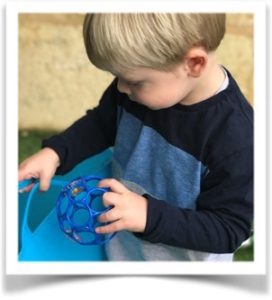
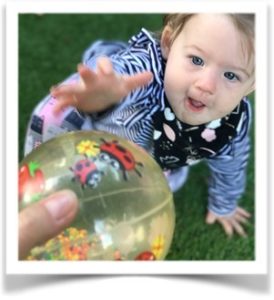
4. Action words
Verbs are action words. All sentences must contain a verb. So a simple sentence like “roll ball” IS a sentence. It’s so easy to get into the habit of pointing out objects to small children without labelling the action. You know the feeling, you’re the walking dictionary labelling what your child points to. If your child can label items you point to, you’ve already done a great job (insert back pat here).
When child is already saying the names of objects such as “ball” you can make sentences (yay!). I tend to stick to two main actions at a time. So “go” and “stop” are great starters. Then just go to town saying “ball go”, “go ball” , “let’s go”, “ready set go”, “ball stop”, “stop ball”, “uh oh stop”.
Don’t worry if you feel like a broken record, children need to hear a word many, many times b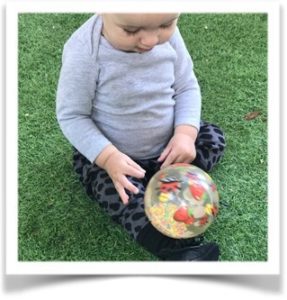 efore they use it. If you have older children you already know that saying “get dressed” needs to be repeated ad infinitum to get a response.
efore they use it. If you have older children you already know that saying “get dressed” needs to be repeated ad infinitum to get a response.
There’s no right way to make simple sentences, the action word can be first or last. What matters is that sentences happen at the same time the action happens. Their little brains are full of neurons (brain wiring) ready to make the connection between the actions and the language. So chat away, roll away and wire up those little brains.
Use these verbs to teach early actions;
- “go”
- “roll”
- “stop”
5. Size concepts
Ok let’s start with the speechie info (yawn). Size adjectives are other early concepts children learn to add information to words. Balls are useful to learn sizes. Not only can you talk about big and little in terms of the size of the balls but also big and little “rolls”. Any balls with an obvious size difference is fine.
Usually teaching with opposites helps kids get the idea. For instance you 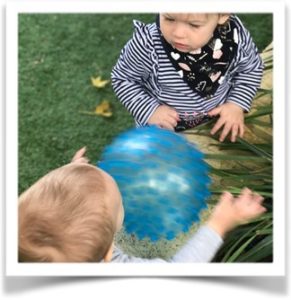 learn “open” when you see it’s the opposite of “shut”, learn “go” because you see it’s the opposite of “stop”. I like to use a BIG voice and arms wide to emphasise the concept of big and a little voice that’s slightly higher pitch to teach little.
learn “open” when you see it’s the opposite of “shut”, learn “go” because you see it’s the opposite of “stop”. I like to use a BIG voice and arms wide to emphasise the concept of big and a little voice that’s slightly higher pitch to teach little.
This is a cool time to let your cray-cray side loose and all kids love a side dish of crazy town. You can bounce the big ball high shouting “big” or ditch the ball too far saying “uh oh big roll”, or do a teeny tiny bounce with the little ball and say “little”. Then it’s their time to go nuts while you do a Dennis Cometti (Does that show my age?) and commentate their actions. “Big bounce”, “big ball”, “BIG!!!”
Try the following to teach sizes using balls;
- Have two balls with obvious size differences.
- Offer the balls and label, label, label “the BIG ball” “roll BIG ball”
- Try doing a little roll that doesn’t go far “Uh oh little roll” and a big roll that goes further “Oooh big roll”
- Do a BIG bounce and a little bounce
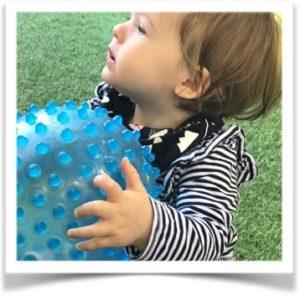
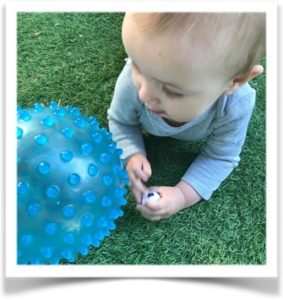
6. Colours
Adjectives are describing words and colours are one of the first adjectives children learn. Children typically learn primary colours first (red, blue and yellow). Personally I shudder at toys in these bright primary colours as it totally jars my house decor. Furthermore bright kiddy toy colours ruin a perfectly harmonious Insta feed too but enough about my OCD issues. I tend to keep these super bright objects in baskets ready to spill out like shiny orbs of excitement. Having a choice of coloured balls is fabulous because once your child is using the word “ball” and engaged in ball rolling, you can help teach colours.
Children love bright colours and will often reach for those red, yellow and blue balls first. I tend to lay them in a row and whatever your child leans towards I label. “Ooh red”, “red ball”, “its red”- clearly I LOVE the sound of my own voice (ask my husband). Then I also hand different colours labelling these also. This is a great opportunity to add colour words to their utterances. If they say “ball”, I say “yay blue ball” or “yes blue ball” or “the ball is blue”
Whilst I act like a partially demented parrot sometimes (repeating phrases over and over) I also give pauses for them to respond, or the words to sink in. So if you feel like you’re going quietly insane then take a breath and let it all sink in. Children’s brains are like sponges, they soak everything in, sometimes they suck it in, sometimes they absorb it and eventually when they “get” it they let it all out, Oh happy day!
You can do the following to teach colours with balls;
- Offering a choice “red or blue”
- Labelling the colour repeatedly “red ball” “it’s red”
- Adding colour words. For example if your child says “more” say “more red”. If your child says “ball” say “yes blue ball”
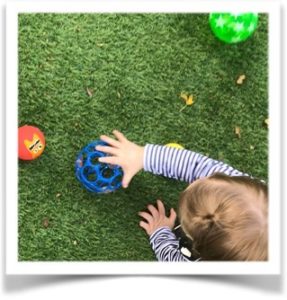
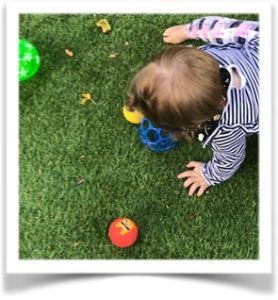
7. Location words
Prepositions or location words are important concepts for building sentences, understanding instructions and developing language. Children learn “in” and “on” first followed by “under” and “behind”. Balls are fantastic to really show the concept of prepositions.
In English there’s this weird little unwritten rule that you describe words in THIS order, size then colour. However, locations words can change. For example you would say “big, red ball” but never “red, big ball” it’s odd but it’s just how it is. No wonder English is so hard for kids to learn. You can say “in the box is a big, red ball” or “the big, red ball is in the box” and both are fine.
Usually I start with “in” because balls naturally go in boxes or baskets or pots as opposed to on. You can gather boxes, bins (preferable empty ?) or other containers and ditch balls in them. Obviously kid’s ball skills aren’t brilliant when they are young so most won’t go in. My ball skills are rubbish so mine mostly don’t go in either but I just pretend it’s part of the plan. Then, like a footballer scoring a goal, we jump up and down shouting “in”, “ball in”, “it’s in” or “woohoo in”. If you know me, I’m actually NOT pretending when I get excited I threw a ball in- seriously I’m that bad.
You can then try “hide and seek” with the ball rolling it under or placing it on objects. As they find the ball or balls you can label the location “it was on the chair”, “ball on”, “on the chair”, “yay it’s on the chair”.
Here are some great ideas to try;
- Here are some great ideas to try;
- Putting a ball “on” objects or pictures.
- Rolling a ball “under” a table or chair.
- Remember to emphasise the key word and repeat.
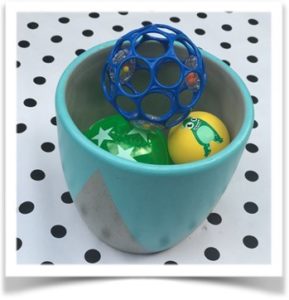
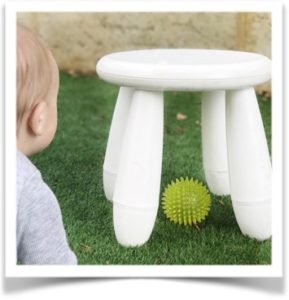
I hope you found this interesting and informative. You don’t need to be sporty to play with balls (I certainly am not sporty or co-ordinated but that’s another story), you don’t need to be a speechie or therapist, you don’t need special toys or a big space. Just 5 minutes, a sense of humour, a willingness to act a little bit crazy and a child ready for some fun. Language happens when children are engaged, motivated and interested and given many many opportunities to learn. Don’t sweat the speech output. It won’t happen in one session or two but it WILL happen and then you can celebrate together.
HAVE FUN!!
Comments
Leave a Reply
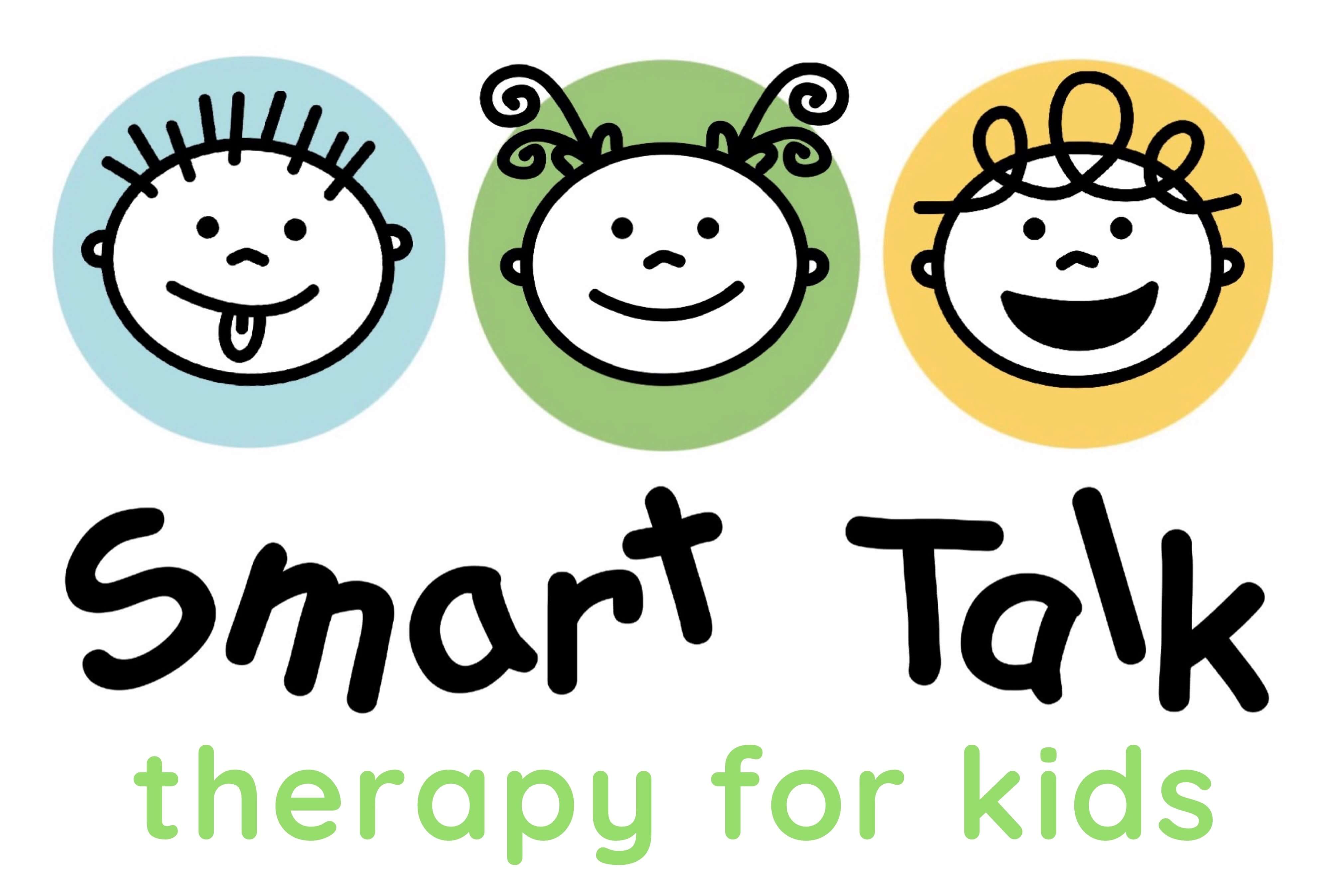
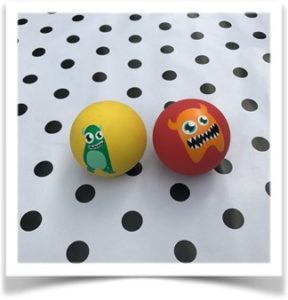

Excellent post, thanks so much for sharing. As an early childhood teacher it is fantastic to see the activities being playful and fun!.
Thank you Lynne. We love fun activities. Our next blog post is about story telling.
There is some really great info here. I am a believer of play based learning so it’s really great to read about some practical suggestions and ideas on how to do it! Thank you for sharing your knowledge ☺️
Thanks Jasmina
Play IS fun, thanks for reading.
Thank you so much, So many great suggestions here. I can’t wait to try some of these with Rosie. I need to invest in some more balls to start!
Balls are so perfect to play with in the upcoming sunny weather too.
Wish I had read this when I had my first son! So many great tips 🙂
Thank you. My first son wasn’t that interested in balls (still isn’t) but my second one is. The process of researching this blog post has helped me make a simple game of ball into a learning opportunity without expending extra time effort or money. Win-win. Cx